Colchester Corporation Tramways
History
Colchester's tramway story started as far back as 1883, when powers were obtained to build a steam tramway in the town, though the company only got as far as laying track before failing financially. It was to be over a quarter of a century later before the next scheme appeared (in 1899), this time for an electric tramway. This was promoted by the British Electric Traction Company under a Light Railway Order, which the Light Railway Commissioners, however, rejected (on the 15th August 1899), citing the urban nature of the system. This must have been quite galling for the BETCo, as the commissioners were subsequently to approve many wholly urban tramway schemes under Light Railway Orders.
Success finally arrived in the shape of Colchester Corporation, which obtained powers to construct a 3ft 6in-gauge, municipally operated, overhead electric system in 1901. Construction was, however, to be delayed until 1904 due to a faction within the council that opposed the tramway, and which favoured the motorbus, which at the time relied on unproven technology. Agreement was finally reached in February 1903; once construction started in February 1904, progress was rapid, the system opening five months later on the 28th July 1904.
The initial system was 5.13 miles long, reaching its final size of 5.74 miles on the 28th January 1906 with the opening of the only extension built, which was to St Botolphs. The system comprised lines running: westwards from Head Street along Lexden Road to Lexden, where there was a terminus opposite Straight Road; northwards from Head Street along North Hill to the Great Eastern Railway's Colchester North Station; eastwards from Head Street along High Street, East Hill and East Street to East Gates; and southwards from the end of High Street along Queen St to St Botolphs Station (also owned by the GER), where the lines diverged, one running eastwards along Magdalen Street to Hythe, the other running southeastwards along Military Road to a terminus near the Recreation Ground.
Like many tramway systems across the country, Colchester's suffered during the Great War from loss of staff (and skills) to the armed services, and an inability to carry out anything but the bare minimum of track and vehicle maintenance. As a result, the system emerged from the conflict in badly run-down condition.
Whilst the system seems may have been profitable (this is unclear), the corporation made little or no effort to build up a renewals/reserve fund, and showed little or no interest in modernising the system (the 18 trams acquired in 1904 and 1906 being neither supplemented nor modernised); therefore, when major track and tramcar renewals were called for in the mid-1920s, the corporation simply opted to close the system, taking this decision in 1927. That same year, powers were obtained to operate motorbuses within the borough, as well as to run trolleybuses (or motorbuses) over the tram routes. The council pressed on with its plans for municipal operation, despite several offers from motorbus operators to pay an annual rent in exchange for the council closing the tramway system and granting them a concession.
The first tram service to be withdrawn was from North Street to East Street on the 21st May 1928, the last tram of all running just over six months later on the North Street to Recreation Ground route, on the 8th December 1929.
Uniforms
Motormen and conductors were issued with double-breasted, lancer-style tunics with five pairs of buttons — narrowing from top to bottom and bearing the full system title (see link) — and with stand-up collars; the latter bore an employee number on the bearer's left-hand side (in individual metal numerals) and system initials — 'C C T' — on the right-hand side (in individual metal letters). The tensioned-crown peaked caps bore standard, off-the-shelf, script-lettering grade badges, either 'Motorman' or 'Conductor'. Buttons and badges were probably brass to start with, though at some point a change was probably made to nickel.
Although the basic style of the uniform essentially remained unchanged for the entire 25 years of the system's life, there does appear to have been a short interlude (possibly around 1907/8) when a different style of uniform was tried. The jackets were double-breasted with three pairs of buttons, and lapels; the caps and all the insignia remained the same as the earlier (and later) uniforms.
Tramcar crews were also issued with double-breasted greatcoats with five pairs of buttons and high-fold-over collars; these garments do not appear to have carried any insignia. In later years, the greatcoats bore epaulettes, which carried system initials — 'C C T' — in individual metal letters.
Inspectors wore single-breasted jackets with hidden buttons (or more likely a hook and eye affair) and a slit breast pocket, all edged in a finer material than the main body of the jacket, this also being used, in the form of a chevron, to embellish the sleeves. The jacket had upright collars that bore system initials — 'C C T' — in an elaborate embroidered script. Caps were of the drooping-peak type, with the peaks embellished with braid; they bore the grade (in embroidered script-lettering) on a hat band. In all likelihood, the drooping-peak caps would have been superseded at some point by tensioned-crown peaked caps, similar to those worn by tramcar crews, though photographic evidence for this is currently lacking.
In common with the vast majority of UK tramways, Colchester employed the services of female staff during the Great War — as conductresses — to replace male staff lost to the armed services. These ladies, the first four of whom commenced work in 1916, were issued with tailored, single-breasted jackets with five buttons, two hip-level pockets (with button closures), a waist belt and lapels; the collars were initially left plain, but subsequently carried an employee number on the bearer's left-hand side, and system initials — 'C C T' — on the right-hand side. Headgear initially took the form of a felt bonnet, which carried a standard, off-the-shelf, grade badge — 'Conductor' — affixed to a wide hat band. Wide-crown peaked caps were also worn; these probably superseded the bonnets. Waterproof bonnets were also worn, probably seasonally. It is currently unclear whether Colchester dispensed with the services of its conductresses after the Great War (this was usually the case) or whether some were kept on.
Further reading
For a history of the system see: 'The Tramways of East Anglia — Chapter 2' by R C Anderson; The Light Railway Transport League (1969).
Images
Motormen and conductors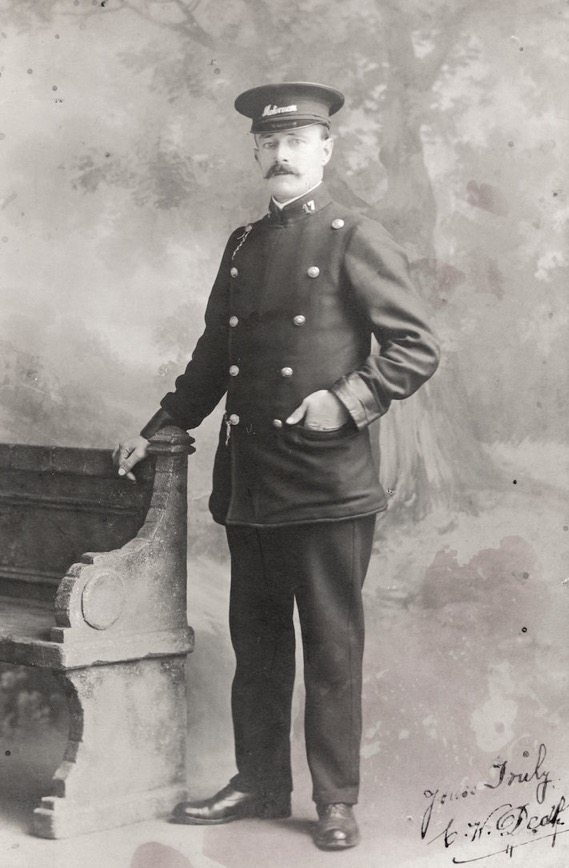
A fine studio portrait of a Colchester Corporation Tramways motorman, Employee No 17 — photo undated, but probably taken around the time of opening, i.e., 1904 or 1905. Photo by Whitfield, Crosser and Company; Author's Collection.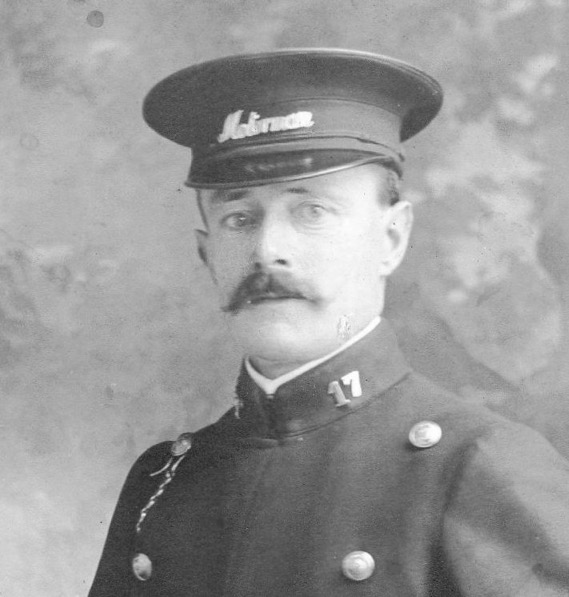
An enlargement of the above photograph, showing details of the uniform. The cap badge is a standard, off-the-shelf, script-lettering, grade badge.
Script-lettering grade badges of the type used by Colchester Corporation Tramways on tramcar crew caps — brass. Author's Collection.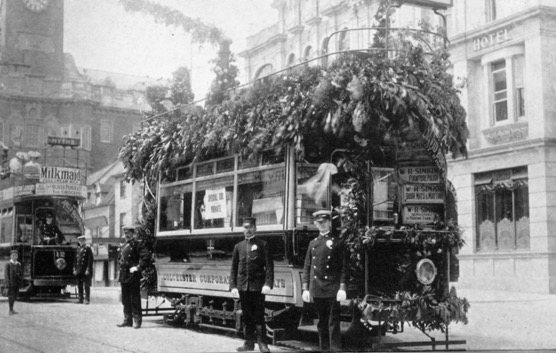
A specially decorated tram on private hire to a Mr Bunting — a local nurseryman — on the occasion of his daughter's wedding and reception in 1905. Although the motorman (right) appears to be wearing a licence badge, this is not seen in other photographs, so is in all probability a button hole. Photo courtesy of the Tramways and Light Railway Society, with thanks to David Voice.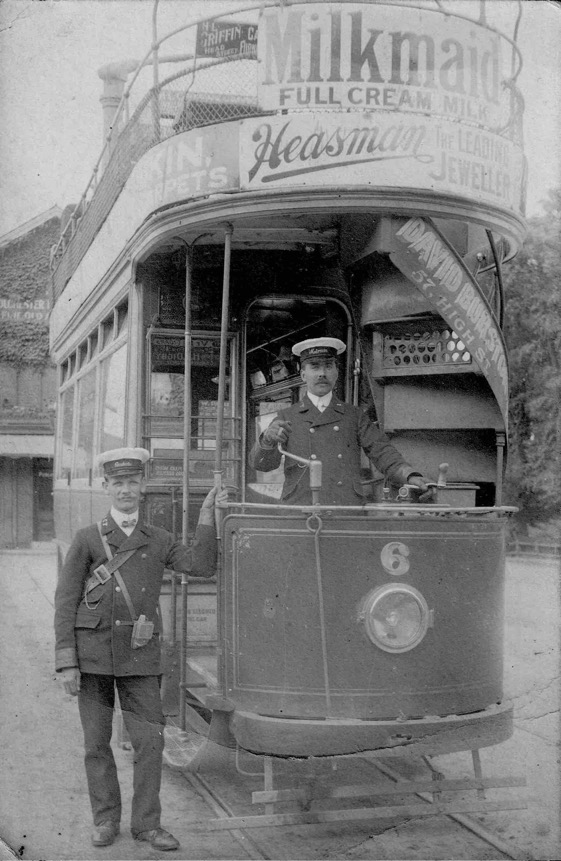
A photograph that is unfortunately not dated, but which was possibly taken around 1907/8; it was postally used on the 11th May 1909. The crew of Tramcar No 6 are both wearing double-breasted jackets with lapels, and according to the rear of the postcard, one of them was called Edgar. Author's Collection.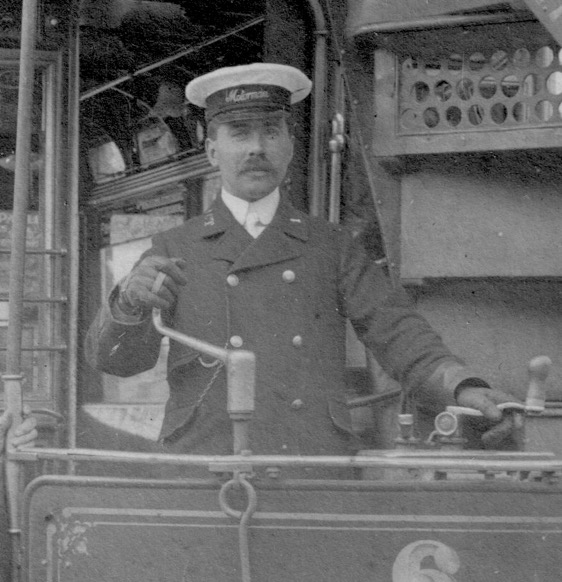
An enlargement of the above photograph showing the motorman, who is wearing a smart double-breasted jacket with three pairs of buttons and lapels; he is Employee No 1. Both his cap, and the conductor's, carry white rain covers, which would have been worn in summer. 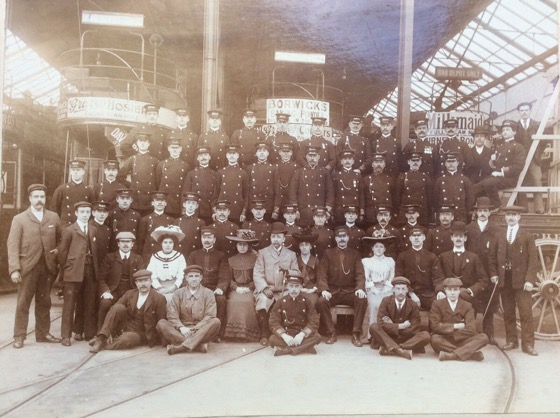
A staff photo taken at Magdelen Street depot, purportedly in 1910.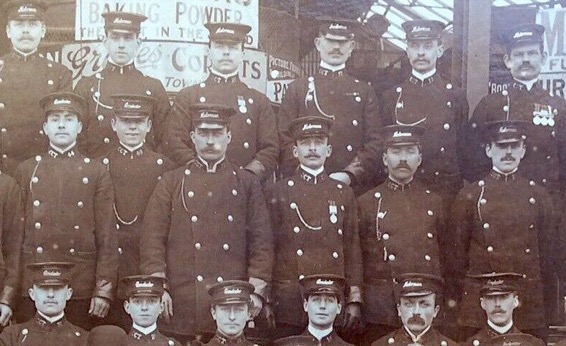
An enlargement of the above photograph showing a number of motormen and conductors. They are all wearing double-breasted, lancer-style tunics with off-the-shelf, grade badges on their caps. The motorman second from the right on the middle row is Employee No 1, and is presumably the same man who is at the controls of Tramcar No 6 (shown above).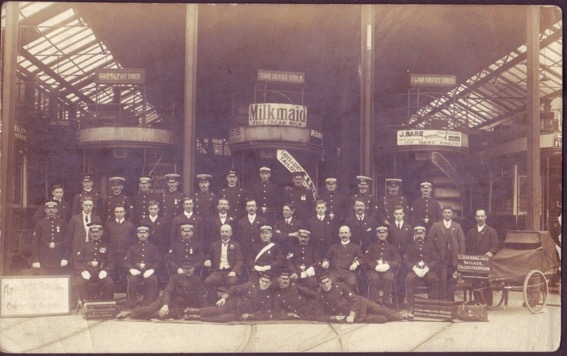
Colchester Corporation Tramways St Johns Ambulance Brigade — photo undated, but possibly taken shortly before the Great War. Source unknown.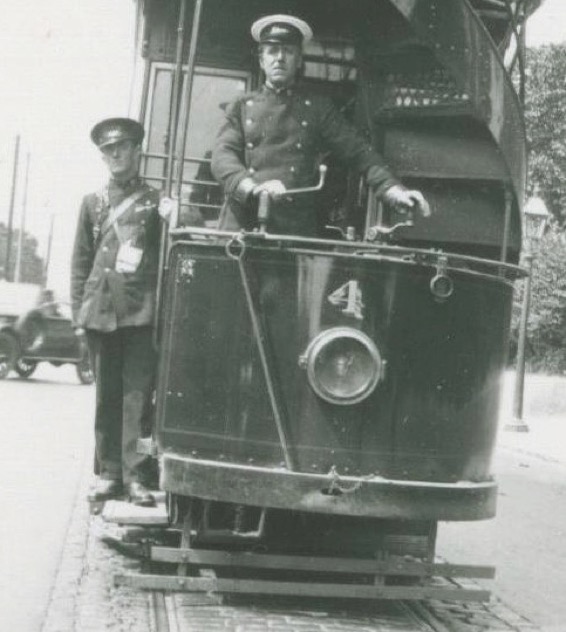
The crew of Tramcar No 4 on the Lexden route — photo undated, but probably taken in the 1920s. The motorman is wearing a white rain cover on his cap, so it was presumably summer. Photo courtesy of Colchester and Ipswich Museum Service (see link).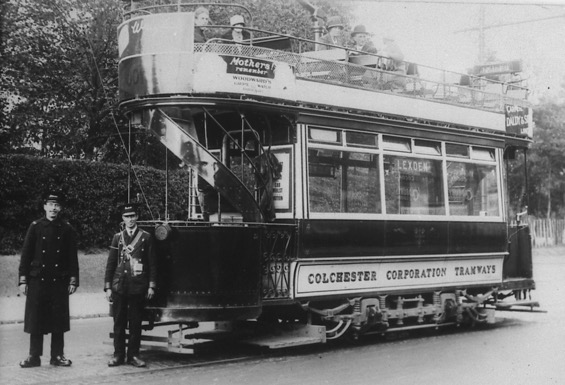
The crew of Tramcar No 6 pose for the camera, possibly on Lexden Rd — photo undated, but from the fashions on display, almost certainly taken during the 1920s. Photo courtesy of the Tramways and Light Railway Society, with thanks to David Voice.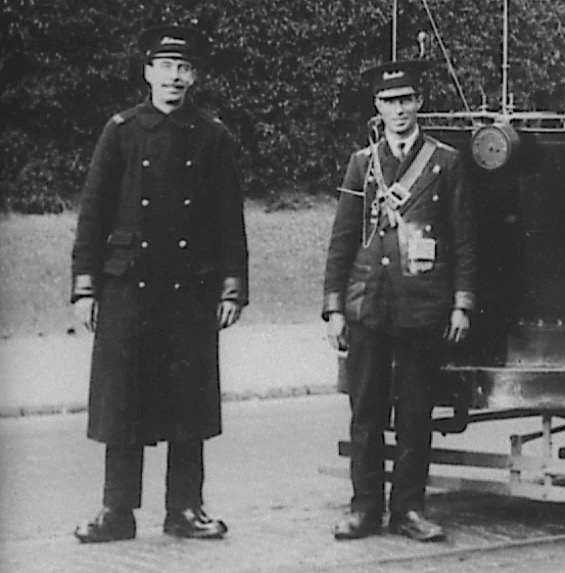
An enlargement of the preceding photograph showing the crew, the motorman in greatcoat with system initials on his epaulettes, the conductor in a lancer-style tunic unbuttoned at the top.
Senior staff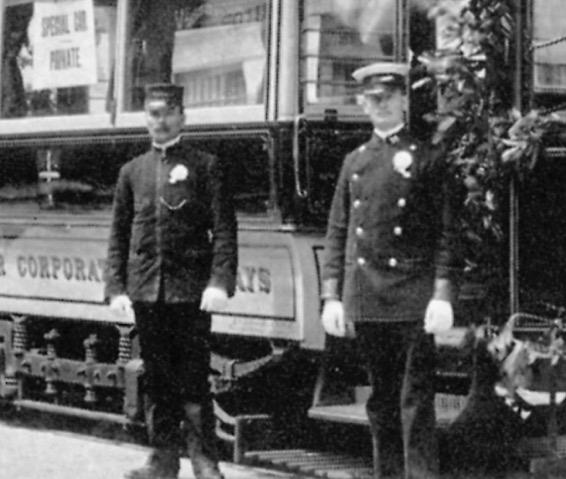
An enlargement of the 1905 private-hire photograph above showing an inspector in drooping-peak cap (left) and a motorman (right).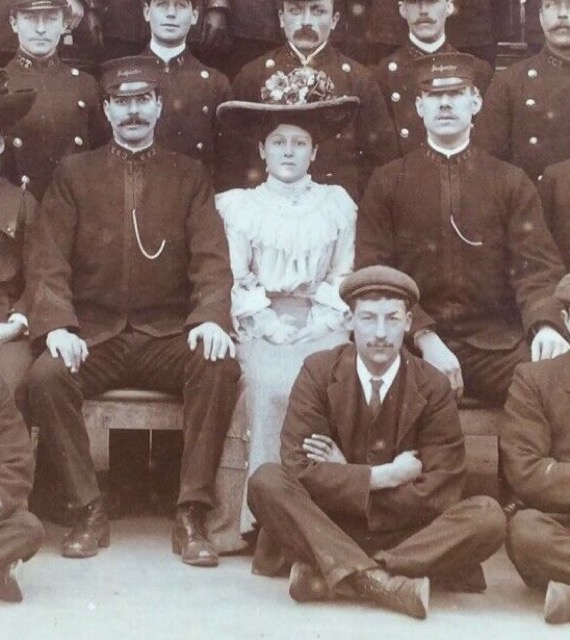
An enlargement of the c1910 depot photograph above showing two of the inspectors. Their collars bear script-lettering systems initials ('C C T') whilst their drooping-peak caps carry the grade ('Inspector'), again in embroidered script lettering.
Female staff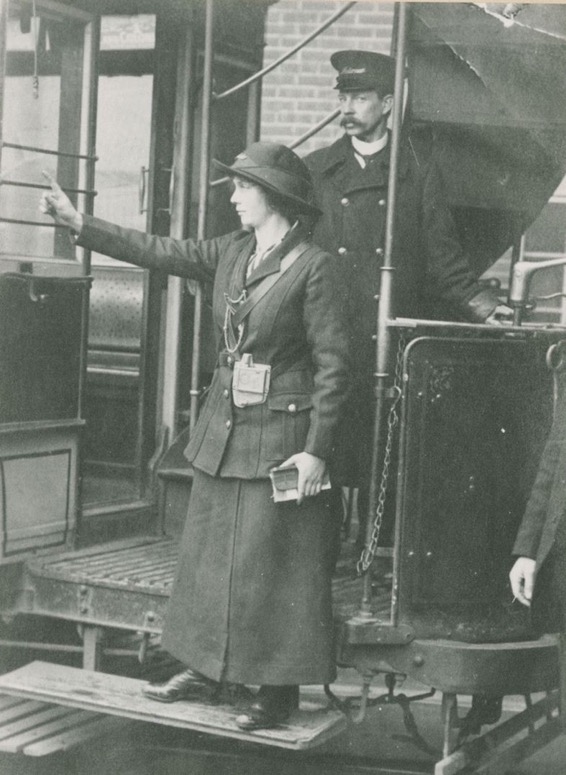
Miss Ann Cudden, one of Colchester’s first batch of four Great War conductresses — photograph taken in 1916, no doubt as a publicity shot to mark the occasion. Photo courtesy of Colchester and Ipswich Museum Service (see link).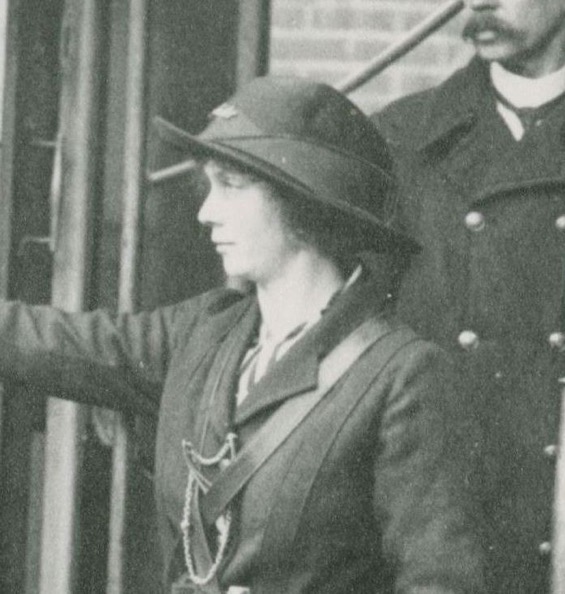
An enlargement of the above photograph showing details of the uniform. Miss Cudden's felt bonnet carries a standard 'Conductor' grade badge affixed to a wide hat band; the jacket lapels and collars are devoid of insignia.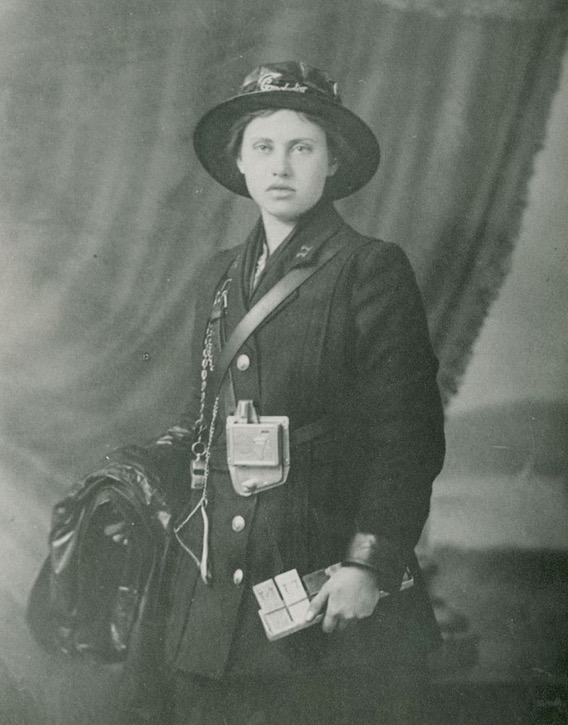
An evocative studio portrait of an unknown Great War Colchester Corporation Tramways conductress. Photo courtesy of Colchester and Ipswich Museum Service (see link).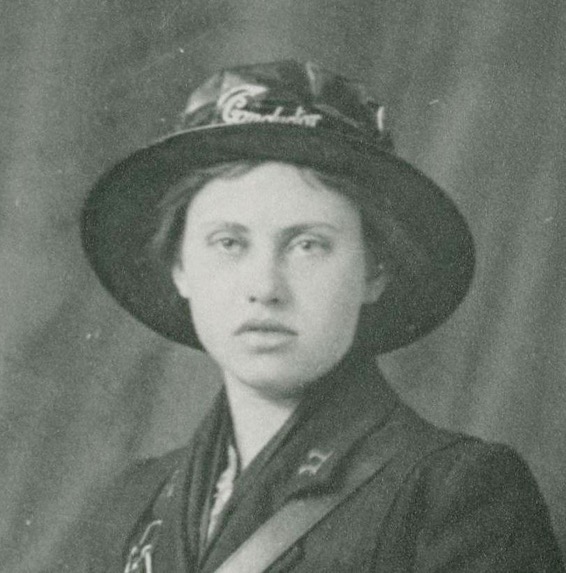
An enlargement of the above photograph, revealing the subject to be Employee No 11 (collar insignia). In contrast to the felt bonnet seen in the previous photo, the bonnet here is clearly waterproof.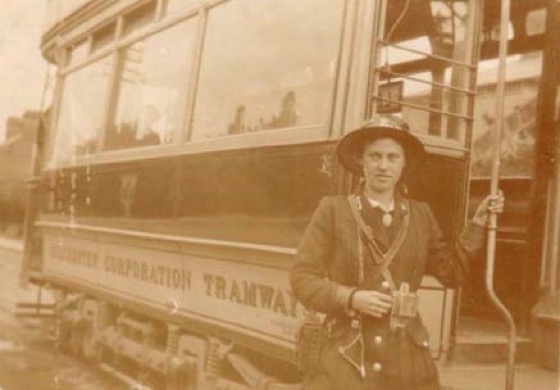
A conductress, again in waterproof bonnet, and with metal collar insignia, 'C C T' — photo undated. Photo courtesy of the Tramways and Light Railway Society, with thanks to David Voice.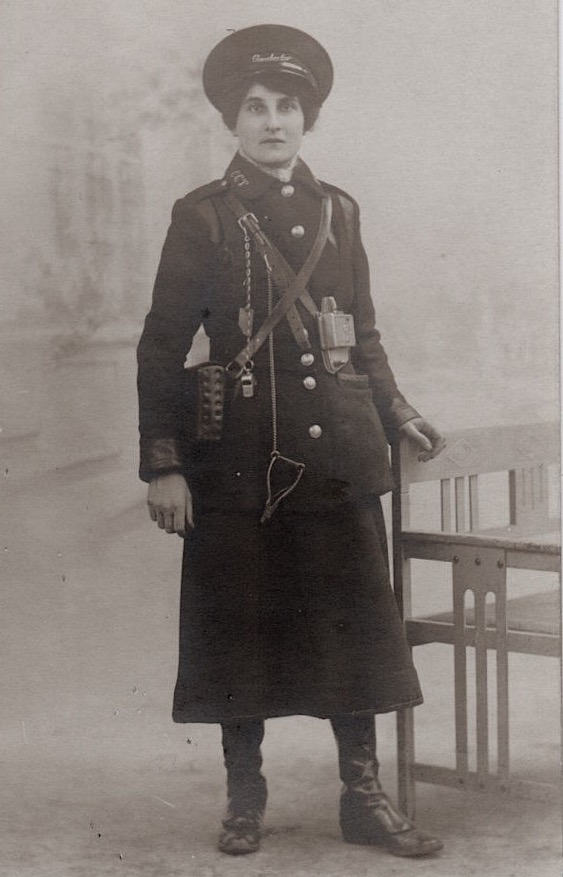
A studio portrait of an unknown Colchester Corporation Tramways conductress — photo dated 1917. The subject is wearing a wide-crown peaked cap rather than the usual bonnet. Source unknown.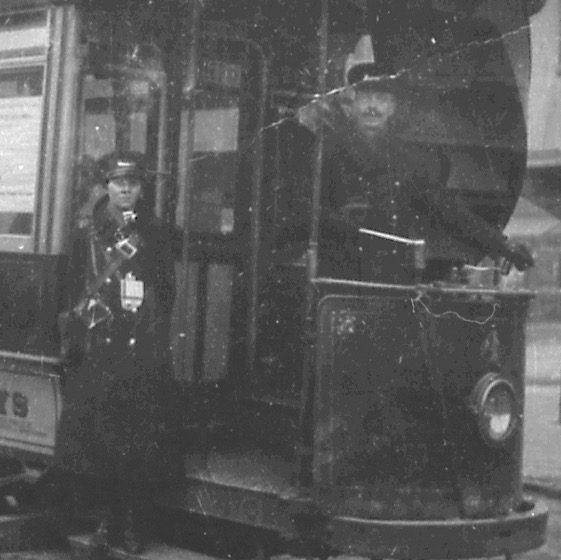
A poor quality photograph (of Tramcar No 4 at Hythe terminus), but one which does show a conductress in a greatcoat — photo undated, but probably taken in the Great War or shortly afterwards. The conductress's greatcoat is seemingly devoid of insignia, whilst her headgear appears to be a wide-crown peaked cap rather than a bonnet. Photo courtesy of the Tramways and Light Railway Society, with thanks to David Voice.